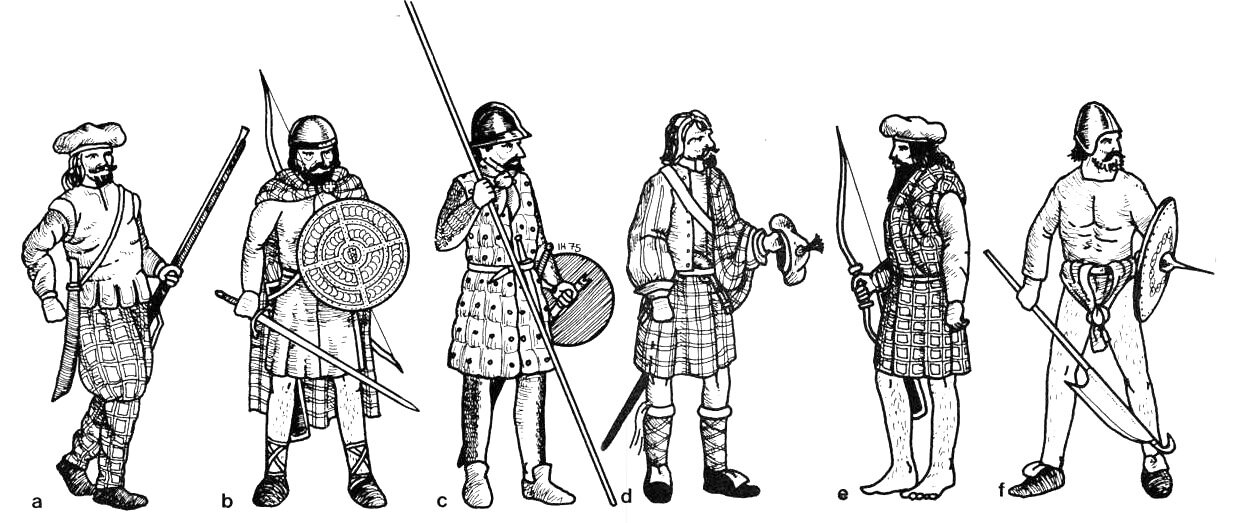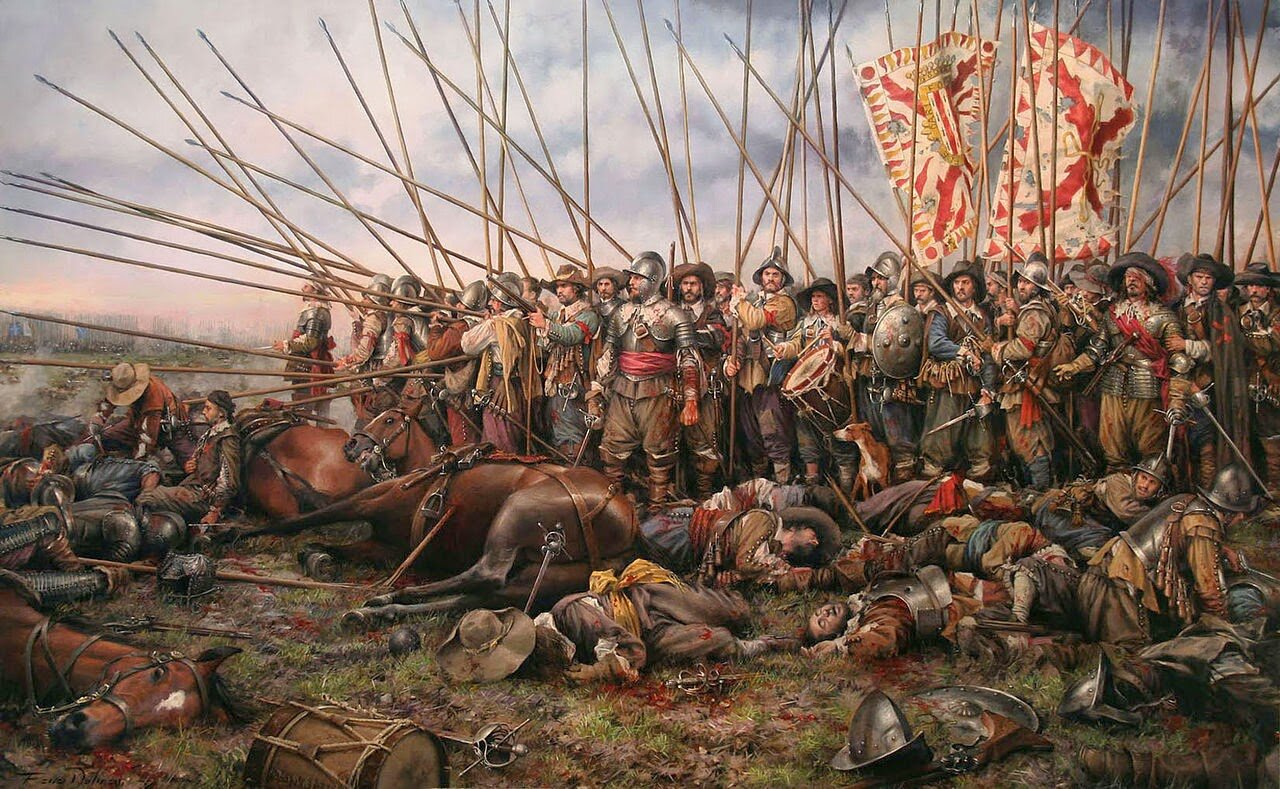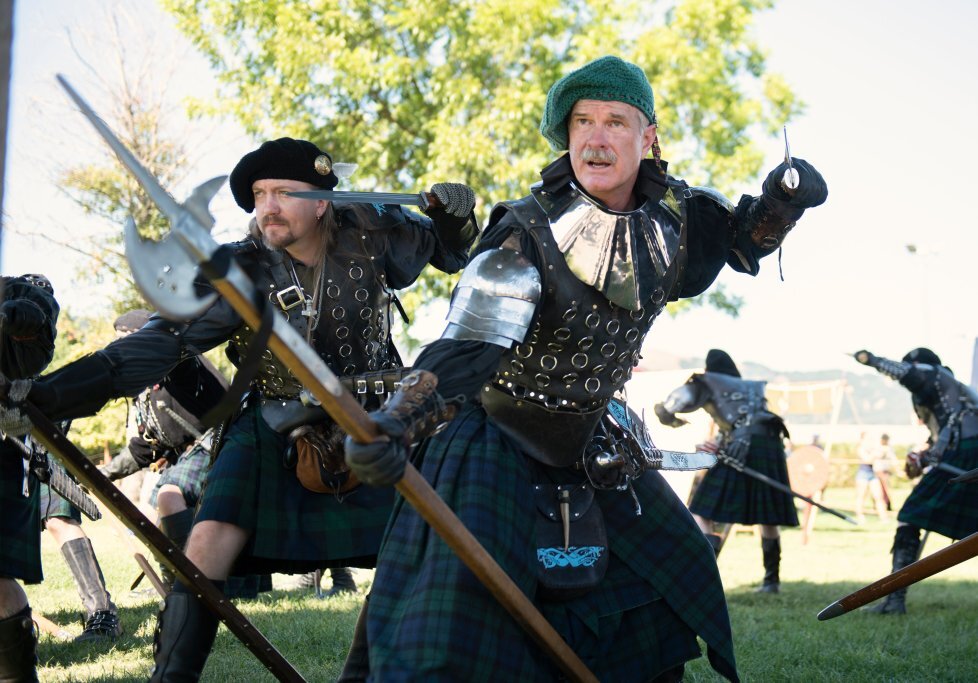AXE and PIKE
Stone Axe
Period: 3000 BC
Length: 13 cm / 5”
Width: 6cm / 2”
The use of stone axes dates back to the earliest times.
An axe head such as this would have required several days to shape with the limited techniques available.
The stone selected would be as close as possible to the required shape to minimise work.
A hole for mounting a handle is drilled or ground through the hammer and the stone shaped by chipping and grinding.
The final finish would be ground and polished by hand and the stone fixed to its handle with sinews or flax.
Flint axes with sharpened edges would have been used for a variety of purposes including hunting and tree felling, but it is likely that special axe or war hammer weapons evolved for use in conflict.
Probably some of the weapons would have been used for ceremony and highly prized and examples can be found from early periods throughout Scotland.
Bronze Axe
Period: 2000 BC
Length: 15 cm / 6”
Width: 10cm / 4”
Copper mixed with tin produces the alloy called bronze and this material can be cast into shapes for many uses. This simple axe design could be cast from a mould of sand or stone.
The design is representative of early examples and would be bound to a wood or bone handle with sinews and pitch. Later designs incorporate internal sockets for mounting on the handle and loops or ears to make the lashings more secure.
Bronze offered significant advantages in the construction of weapons and could be cast or beaten into a variety of shapes. This beating also had the advantage of hardening the metal. The blade of an axe such as this could be sharpened to a fine edge but would wear quickly and damage easily.
The blade could be reworked several times but eventually the material of the axe would be smelted for re-use in new bronze objects.
Halberd
Period: 2000 BC
Length: 1 meter / 40”
A Halberd can be described as a cutting axe or pike and has many variations throughout history.
The halberd or battle-axe was a Swiss invention which was a combination of spear and axe on a long handle. It was a direct descendant of the old Gallowglass two-handed, 12 inch bladed axe and was particularly effective against horsemen since the foot soldier could cut and thrust with it.
The orientation of the blade allows the Halberd to be used in a hacking motion.
This type of weapon demonstrates the development of weapons aimed primarily at warfare rather than hunting, as the Halberd would be of little use in any activity other than armed conflict..
The bronze blade of the Halberd is cast using similar techniques to bronze sword and dagger blades. Holes in the casting allow the blade to be fixed at 90 deg to the wooden handle with bronze rivets. Additional strength would be provided by adding pitch and sinew bindings.
Squarehead Axe
Period: 500 AD
Length: 90 cm / 36”
The Pictish people are surrounded in mystery as there is little tangible evidence of their culture and society. It is clear that they were a warlike race and had developed many skills in metallurgy and ironwork. Weapons were influenced by Roman design but the Picts were never settled by a Roman occupation force.
The Squarehead Axe is a distinctive Pictish design.
The iron blade is cast and the cutting blade sharpened and tempered.
Skills in metalworking were well respected and the technical requirements of working in iron required considerable experience and smelting furnaces.
This axe design and its oak shaft provided a sturdy and effective weapon.
Curved axe
Period: 1100 AD
Length: 1.2 metres / 48”
The use of the axe in battle continued for most of the period of plate and chain armour. This armour provided considerable protection against a sword blow or an arrow or spear strike. It also provided some protection against an axe blow but the momentum of the heavy axe head was likely to break through the armour, or at least inflict a crippling wound on the wearer.
The curved axe head is forged from iron with a tempered cutting edge.
The head weighs several kilograms and would be capable of striking a fatal blow.
The shaft has a strong leather thong fitted to improve the grip and achieve a full swing of the axe.
The reverse spike on the head would be used to open up gaps in the opponents armour. The shaft tip also has a spike for thrusting and stabbing.
Schiltron Pike
Period: 1300 AD
Length: 3.5 metres / 138”
The Schiltron Pike gets its name from a defensive formation deployed against horse mounted attack.
The long and heavy spears are held at increasing angles by three rows of foot soldiers, protected by wooden spikes embedded in the ground in front of the line. It is thought that this tactic was used by William Wallace at the battle of Falkirk 1298.
The Schiltron Pike of the period was a simple sturdy weapon
The head is a pointed iron cross head pinned onto the shaft.
The shaft is roughly shaped from local wood cut in lengths up to 12 or 15 feet.
As deployed in a splayed array around a defensive block formation, the Schiltron would have looked quite formidable to an approaching horseman.
A common variety of bill – the long handled Bill
The Bill
Period: 1500 AD
Black Bill Length: 5 or 6 feet (1.5 or 1.8 m)
Forest Bill Length: 8 or 9 feet (2.4 or 2.7 m)
A bill is a class of agricultural implement used for trimming tree limbs, which was often repurposed for use as an infantry polearm. The English distinguished between several varieties of bill, including the black, brown and forest bills, but the differences between them are currently not fully understood. Bills were adapted to military use through addition of various projecting blades.
The bill is similar in size, function and appearance to the halberd; a pole-arm with a point to thrust with, a hook to drag with, and a spike/axe to cut with.
Pike AKA the long pike
Period: 1660 AD
Length: 1.8 metres / 72”
The simple or spear was popular with Scottish regiments. It was a simple weapon to manufacture and required little skill to use on the battlefield.
This Long Pike from the 17th century is typical of the type of pike commonly available.
The features are similar to the Lochaber Axe, though this format is more commonly known as the Irish style "Tuagh".
The front cutting blade and the rear spike were used in a cutting action and the top spike used for thrusting and defence.
Lochaber Axe
Period: 1740 AD
Length: 1.5 metres / 60”
The Lochaber Axe was a weapon of the Highland foot soldier, though it is also associated with the town guards of Aberdeen and Edinburgh as a ceremonial weapon.
The design evolved over years and the Lochaber association is probably related to the source of the staff. The Scots word for the hook or "cleek" is still in use today.
The design of the Lochaber Axe is a form of halberd.
The staff was about six feet long and fitted with a small curved cutting blade about eighteen inches long.
The sharp tip of the blade could also be used as a thrusting and stabbing blade.
The axe is fitted with an additional spike or hook, used to dismount horsemen or to assist in scaling walls.




















